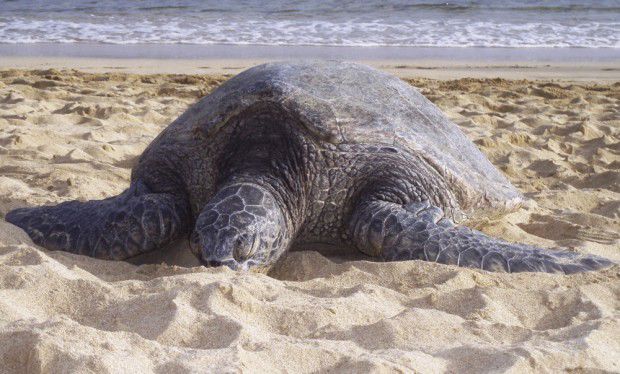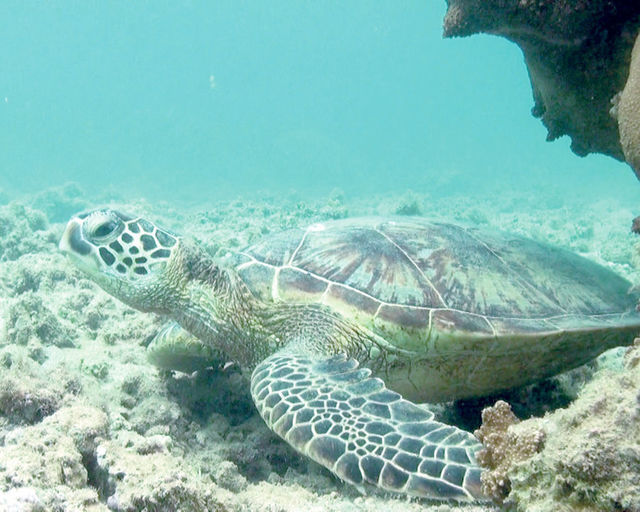PRINCEVILLE — John McCaffrey, owner of a condo just off the eighth tee at the Princeville Makai Golf Course, said one of the best things about his little vacation rental is that it sits right above a place he knows
PRINCEVILLE — John McCaffrey, owner of a condo just off the eighth tee at the Princeville Makai Golf Course, said one of the best things about his little vacation rental is that it sits right above a place he knows as Honu Cove.
In fact, the little inlet has become so special, he adopted the name for marketing his condo and he said his guests frequently comment on the turtles they see from their cliff-top vantage point.
“Having the turtles around is a little bonus, because people — particularly those from the Mainland — don’t get to see them on a regular basis,” McCaffrey said. “ On calm days, when the sun is shining, it’s common to see five or six turtles in there.”
He said he and his wife, Brenda, love seeing the turtles around Kauai, and on Oahu when they venture to that island.
“My wife grew up on the windward shore of Oahu and now, about 60 years later, she’s seen over the many years that turtles are coming back,” McCaffrey said. “They were almost never seen at one point and now they’re a fairly common sight in Hawaii.”
The Hawaiian green sea turtle has been on the endangered species list since 1978, but with populations rebounding, some experts are calling for their removal from that list.
“The whole purpose of being on the list is to rebuild populations so they can be taken off the endangered species list,” said Don Heacock, Kauai’s aquatic district biologist at the Division of Aquatic Resources Branch of the Department of Land and Natural Resources. “We did it with the bald eagle, the gray wolf and the California gray whale and turtle nesting is on the increase. The population is on the increase.”
The national marine fisheries service and U.S. Fish and Wildlife Service announced in April the downgrading of the green sea turtle status from “endangered” to “threatened” on the Endangered Species List.
In a news release announcing the category downgrade, Catherine Kilduff of the Center for Biological Diversity, said the fact that green sea turtles can overcome illegal harvest, plastic pollution and warming waters testifies to their resilience.
“The undeniable recovery of most green sea turtle populations creates a hopeful spot in our changing oceans,” Kilduff said.
According to the National Oceanic and Atmospheric Administration, the Hawaiian green sea turtle population has increased 53 percent over the last 25 years.
It’s estimated that Hawaii has fewer than 4,000 nesting green sea turtles, and 96 percent of them nest at French Frigate Shoals in the northwestern Hawaiian Islands.
Some say the green sea turtle, which are believed to live around 60 years or longer, should remain protected.
“It is my opinion that turtles need to continue to be protected, given all the uncontrolled harm that comes to them and other marine life: poisonous runoff entanglement in nets and longlines, loss of nesting sites by human development and shore damage from ever-larger storm waves, starvation from eating drifting plastic bags,” wrote Katherine Muzik in a previous report in The Garden Island.
Green sea turtles are currently protected under the Endangered Species Act, but they’re also protected by Hawaii state law, which means the species would still be defended if taken off the list.
On Kauai, Heacock responds on a management level to nearly all the sea turtle calls. He said an advantage to delisting the species is that the management funding would go to the state instead of being distributed through multiple sections of the government.
“If a turtle is being harassed, the state responds to those,” Heacock said. “Right now what’s happening is your tax dollars are going to three levels of government at the same time to do basically the same thing.”



